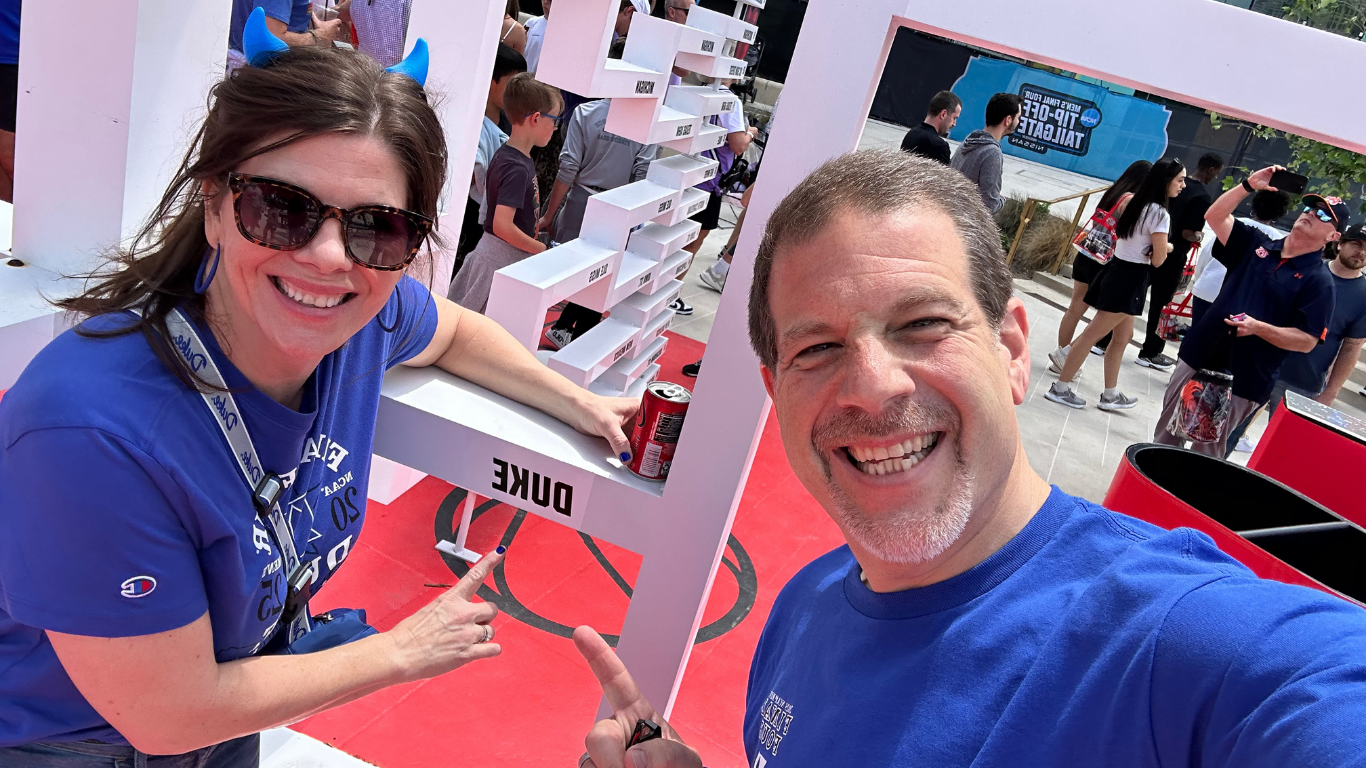
Stay Informed
Get the latest news, trends, and industry insights.
As a lifelong branding agency owner and sports fan, attending the Final Four in San Antonio wasn’t just a bucket list sports experience—it was a masterclass in brand building and experiential marketing. I spent the better part of the last 25 years helping companies define and grow their identities, and few brands have done it better—or more consistently—than the NCAA’s March Madness and the Final Four.
Related Article: 25 Years of Brands: Identity, Authenticity, and the Power of Time
Walking through downtown San Antonio, from the River Walk to the Alamodome, it was clear that this wasn’t just a basketball tournament. It’s a fully immersive brand experience. From the signage, merchandise, and pop-up events to the fan energy pulsing through the city, everything felt cohesive, iconic, and intentional. Fans and coaches, players (both current and past legends—meeting James Worthy, John Calipari, and Christian Laettner, just to name a few, was pretty cool), all walking the same streets, jumping into the same restaurants, bars and events…brilliant.
It got me thinking about just how brilliantly the NCAA has built, protected, and grown the March Madness brand over the years—and what lessons any brand can take from it.
The Power of Consistent, Evolving Branding
March Madness has become one of the most recognizable and emotionally charged sports brands in the world. Think about it: how many other sports events besides the Super Bowl, let alone any other brand globally, can own an entire month in the public consciousness?
That didn’t happen by accident. The NCAA and its partners have treated March Madness like a legacy brand—balancing tradition with innovation. The name alone evokes nostalgia, drama, and excitement. The bracket is a cultural phenomenon. Even people who don’t follow college basketball suddenly care deeply about seedings and Cinderella stories.
And the Final Four? That’s the crown jewel—the pinnacle of the narrative’s journey. It’s where stories are cemented in college basketball lore, and it’s where branding steps into overdrive.
Everything—from the signature court design and typeface to the broadcast music and the “One Shining Moment” montage—is carefully curated. This level of brand consistency is why people tune in every year. They know what to expect, and they want to be part of it.
Protecting the Brand
What’s especially impressive is how well the NCAA has protected the March Madness brand. They’ve built a licensing fortress around the term “March Madness,” and they aggressively enforce it. The term can’t be used commercially without permission. That protects the brand’s value and prevents dilution.
This isn’t just about legal tactics—it’s a strategic move that preserves the integrity and uniqueness of the experience. If every local sports bar or bracket pool could slap “March Madness” on their promo flyers, the brand would lose its power. Instead, the NCAA keeps it special—and in doing so, keeps it valuable.

A Revenue Giant
The results speak for themselves. According to the NCAA’s own financial reports, March Madness generates more than $1 billion annually in media rights, ticket sales, and sponsorships—roughly 90% of the NCAA’s total revenue.
CBS and Turner Sports signed a $8.8 billion, 8-year extension in 2016 to continue broadcasting the tournament through 2032. That’s a staggering vote of confidence in the brand’s staying power.
And the economic impact doesn’t stop with the NCAA. Cities that host the Final Four see huge boosts in revenue. The San Antonio 2018 Final Four reportedly generated an estimated $185 million in economic impact for the city. That’s not just hotel rooms and restaurant tabs—it’s visibility, jobs, and long-term tourism momentum.
In the last 25 years, cities like Indianapolis, Atlanta, Houston, and Minneapolis have all reaped similar benefits. These aren’t one-off paydays—they’re branding wins that echo long after the confetti falls.
The Branding Impact on Schools
The programs that make it to the Final Four? Their brands go to a whole new level. According to a study from the Journal of Sports Economics, schools that make a Final Four appearance see a boost in undergraduate applications by 10-12% the following year. That’s the “Flutie Effect” in action—athletic success fueling broader institutional interest.
Merchandise sales skyrocket. Donations to athletic departments go up. Social media engagement explodes. And for underdog programs, it can be a once-in-a-generation opportunity to step onto the national stage.
The Final Four doesn’t just crown champions. It builds brands. And it drives them dep into the soul of consumers. I don’t say it just as a branding leader, I say it because they got us, too. Despite my wife’s disappointment in 2025 (Lifetime Duke fan. Don’t judge), I admit it, they sucked us in. It was our 1st March Madness, and, well...We’re hooked. Circled on our calendar for future travel in Indianapolis in ’26, and beyond. In fact, as lovers of travel experiences, we don’t care what city hosts; the brand, in and of itself, took over the city—and our hearts—in a special and unforgettable way.
Lessons for the Rest of Us
Here’s what I take away from experiencing March Madness in action:
- Consistency builds trust. People know what to expect from March Madness because it’s delivered a consistent experience for decades. Brands that win long-term don’t reinvent the wheel every year—they evolve with intention.
- Emotion is everything. March Madness taps into identity, pride, nostalgia, and hope. That’s how you build a brand people don’t just like, but love.
- Protect what you’ve built. The NCAA’s strict control over its intellectual property isn’t just legal savvy—it’s brand strategy. Protect your assets, and you protect your value.
- Don’t underestimate the experience. The in-person Final Four experience in San Antonio was unforgettable. Smart brands create moments, not just messages.
As we flew home from Texas, our voice hoarse and digital photo album full, we realized we’d checked off more than just a personal sports bucket list trip. I’d seen, firsthand, what happens when a brand nails every element of its ecosystem: product, audience, emotion, consistency, and vision. March Madness didn’t become iconic by chance. It’s a case study in branding brilliance—and one we can all learn from.
Stay Informed




